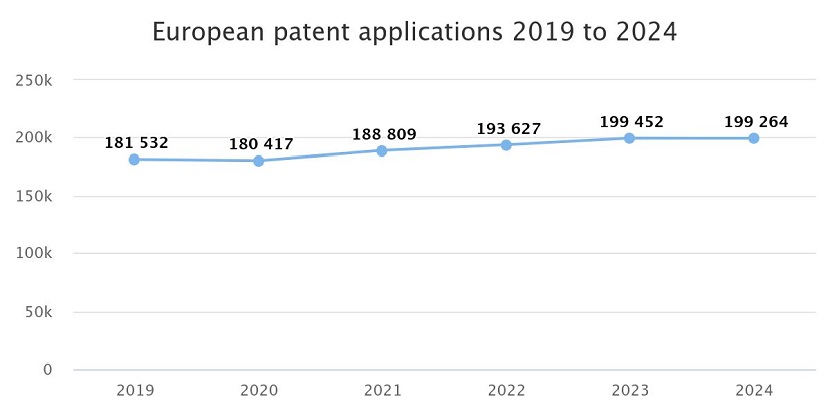EPO statistics show surge in Unitary Patents
Demand for European patents with unitary effect is rising across Europe, even as total patent applications at the European Patent Office showed a slight decline last year. Meanwhile, Samsung displaced Huawei as the company to have filed the most applications in 2024.
26 March 2025 by Mathieu Klos
The downturn remains modest. However, in line with Europe’s economic slowdown, patent applications at the European Patent Office have declined. Between 2020 and 2023, new patent applications rose from 180,417 to 199,452. Compared to 2023, the number of new European patent applications fell by 0.1% in 2024. Inventors filed 199,264 European patents at the EPO. This is according to the Patent Index published by the EPO yesterday.
The last slight decline in application numbers occurred between 2019 and 2020. In 2024, computer technology, including AI areas such as machine learning and pattern recognition, led the field for the first time with 16,815 patent applications. Meanwhile, new applications in digital communications fell by 6.3% to just under 16,000. Applications also declined in pharmaceuticals (-13.2%) and medical devices (-3.0%). However, biotech patent applications rose by 5.4% compared to 2023.

After a prolonged period of growth, applications recently declined slightly ©European Patent Office
According to the report, electrical machinery, apparatus and energy was the second strongest sector last year (+8.9%). Clean energy technologies drove this trend, particularly battery innovation (+24.0%).
Samsung became the new top applicant at the EPO, having last topped the ranking in 2020. Huawei dropped to second place, followed by LG, Qualcomm and RTX. The top 10 applicants comprise four European companies, two from South Korea, two from the US, and one each from China and Japan. Siemens, BASF, Ericsson and Robert Bosch lead the European applicants.
EPO President António Campinos remained positive about the development. “Despite political and economic uncertainties, European companies and inventors filed more patents last year, underlining their technological prowess and their continued investment in R&D,” he said. “The EPO’s patent data is a clear roadmap for industry, policy, and investment priorities. As the Draghi and Letta reports warn, to stay competitive globally, Europe must enhance its innovation ecosystem and do more to help inventors scale up and commercialise their inventions, especially in critical areas such as green technologies, AI and semiconductors.”
Unitary Patents increasingly attractive
In contrast to the overall trend in patent applications, Unitary Patent numbers have grown substantially. Inventors applied for European patents with unitary effect 28,123 times, up 35.6% from 2023. The EPO granted unitary effect in 28,024 cases.
Inventors requested unitary protection for 25.6% of all European patents granted by the EPO in 2024, a 53% increase compared to 2023, when the EPO received 18,300 requests.
In 2024, patentees from EPO member states had the highest uptake rate, with 36.5% of their European patents transformed into Unitary Patents. South Korea followed with 18.9%, then China with 17.9% and the US with 16.0%. Johnson & Johnson, Siemens, Samsung, Qualcomm and Volvo Group topped the list of requestors.
Smaller entities showed even greater interest in the system, with European SMEs and universities having an uptake rate of 57.5%.
In the first quarter of 2025, inventors have filed for 6,532 Unitary Patents. The Unitary Patent, which parties can enforce or challenge at the Unified Patent Court, provides legal protection across 18 EU member states. Companies can opt for protection via the Unitary Patent rather than through national patent bundles, which require individual applications at different patent offices.
The rise in Unitary Patents will likely lead to more lawsuits at the Unified Patent Court in the long term. Case numbers there continue to climb, reaching 752 cases in February. Meanwhile, patent lawsuits at national courts are declining – for example in Germany and the Netherlands. In the UK, High Court cases fell slightly in 2024, while the IPEC saw a modest increase in IP cases compared to the previous year.
